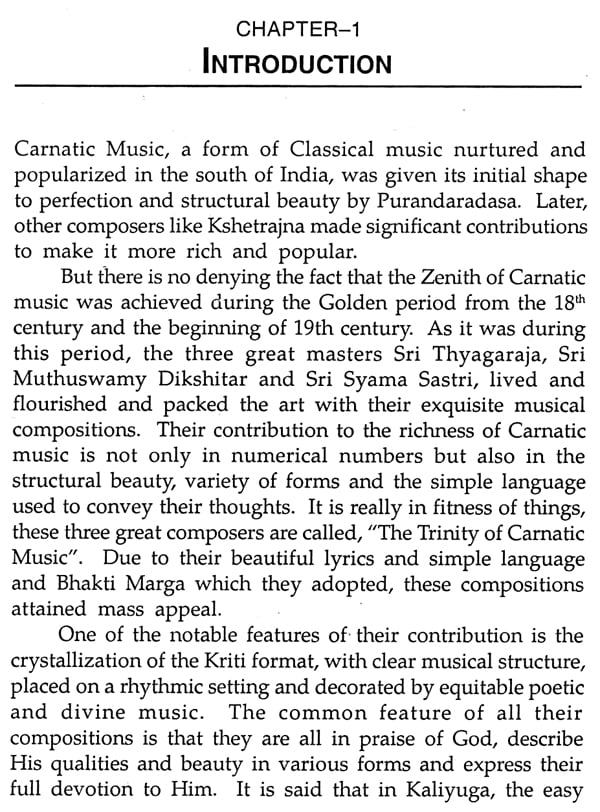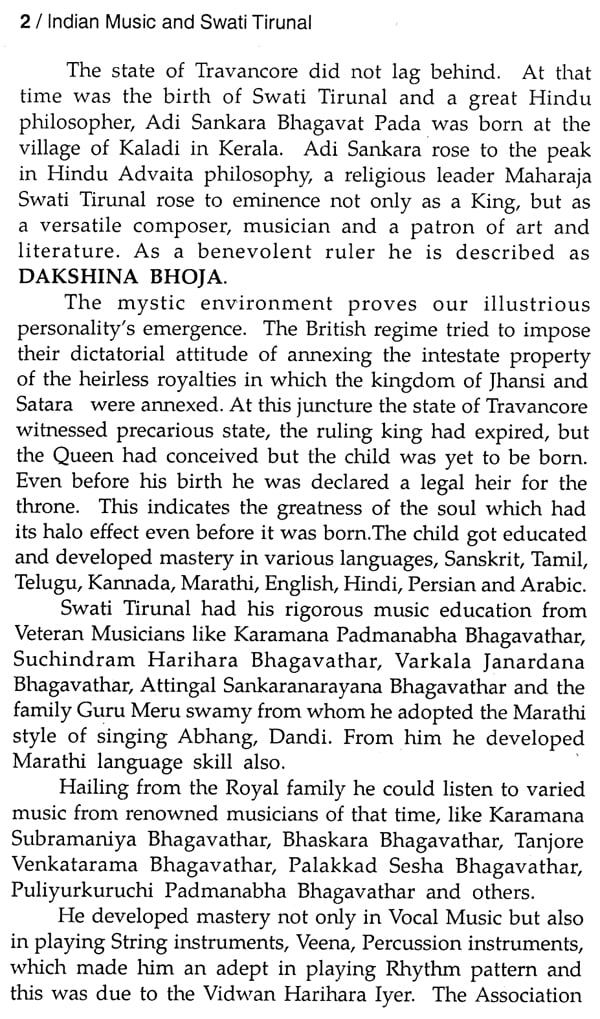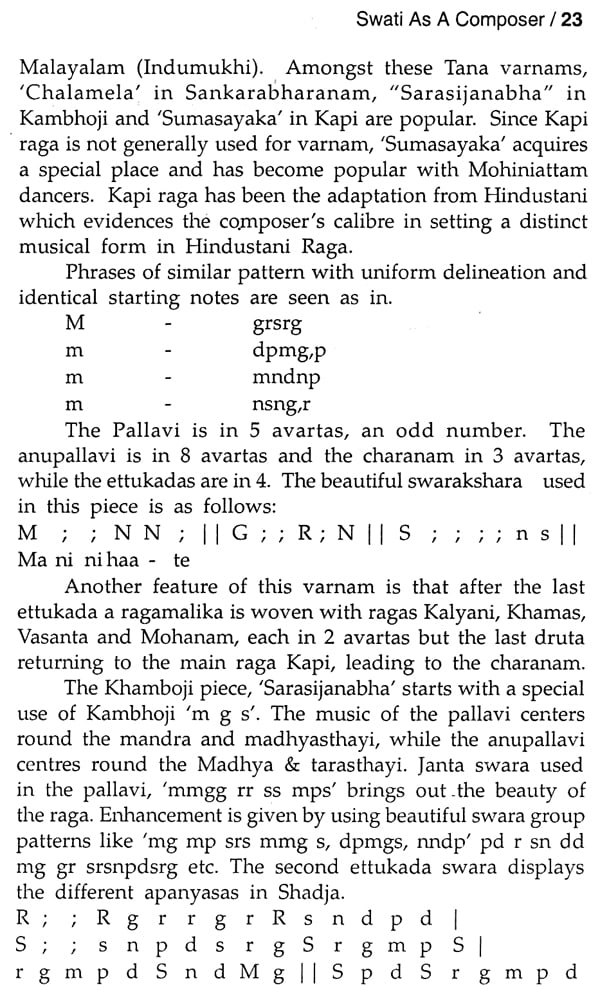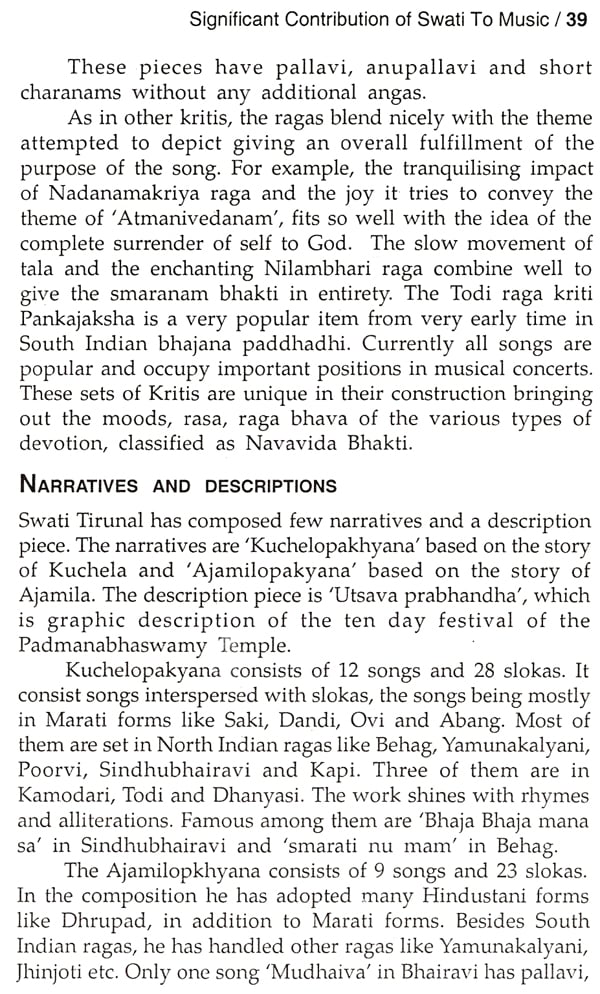
Indian Music and Swati Tirunal
Book Specification
| Item Code: | NAU566 |
| Author: | Vasanthy Rao |
| Publisher: | Sanjay Prakashan |
| Language: | English |
| Edition: | 2006 |
| ISBN: | 9788174532442 |
| Pages: | 58 |
| Cover: | HARDCOVER |
| Other Details | 9.00 X 6.00 inch |
| Weight | 210 gm |
Book Description
Sri Swati Tirunal was Maharaja of Travancore in Kerala. Hailing from a royal family known for the artistic knowledge and patronage of Fine Arts. He lived during the same period of the Music Trinity -t5t Carnatic Music who lived and enriched the art with their enchanting and appealing compositions. Though he lived for short period of 34 years (1813-1847), he acquired mastery over the several languages including Persian, Hindi, and proficiency in Music. He has composed more than 300 songs in various languages which are considered to be equal to those of the Trinity of Music. Besides administering the state admirably, he patronized all art forms. His contribution to the literature on the subject of music are worthy of note.
Dr. Smt. Vasanthy Krishna Rao hails from a family of musicians. Her father, Late Sri. Kumaraswamy Iyer was an eminent artist, who spent his whole life in the service of carnatic music. He retired as Principal of Sri. Swati Tirunal College of Music, Tiruvana-ndapuram. Dr. Vasanthy Krishna Rao had her initial training from her father. She graduated in music from Women's College, Tiruvanan-thapuram. She then qualified for M.A. and M.Phil. in carnatic Music, with distinction from Delhi university. She got Doctorate from the same university in the year 2000. Dr. Vasanthy is an accredited A graded artist of the all India Radio, and Doordarshan. She has travelled widely in India and abroad for her performances. Vasanthy is currently working as Reader in the faculty of Music and Fine arts of the Delhi University.
Although Swati Tirunal lived for only 34 years and ruled over a small kingdom in the southern-most part of India, he left behind a musical empire, which is bound to last for centuries to come and bring joy and peace to generation of music lovers and others. Even before he ascended the throne at the age of thirteen, he had learnt more than half a dozen Indian languages besides English. But his consuming passion was music and in addition to patronizing a large number of musicians, both Carnatic and Hindustani, he himself became an excellent composer and today his creations rank with those of the Trinity, who were his contemporaries. In fact, the history of Carnatic music would have been written differently if his compositions had come to light a century earlier.
What is remarkable about the ruler is his versatility. Besides kirtanas, he has written Chauka Varnas, Pada Varnas, Svaraistis, Padas, Javalis, Tillanas as well as Dhrupads, Khyals and Bhajans in the Hindustani style. His works are too many to be listed here. There are several books on the life and works of Swati Tirunal in English, Tamil, Malayalam and other languages but no critical analysis of his musical output from different angles. Dr. Vasanthy Krishna Rao, the author of this book, is a seasoned performing artiste in the Carnatic style known for her mellifluous voice. As the daughter of Vidwan K. R. Kumaraswamy Iyer, a veteran who was the Principal of the Swati Tirunal Music Academy at Trivandrum, she is closely associated with the musical works of the ruler, Dr. Vasanthy is a M.A., Ph.D and is presently Reader in the faculty of Music and Fine Arts at Delhi University. Her other books entitled, 'Indian Music and Enchanting Amalgam of Dance' is a notable addition to our existing books on dance music.
Swati Tirunal appears to be the author's special subject and she has done intensive research on the ruler's musical creations. The present book of eight chapter's entitled 'Indian Music and Swati Tirunal' is an in-depth study of her favourite subject. After a brief introduction, the various aspects of the ruler's life like his association with musicians, his role as a composer and his significant contribution to music are covered in detail. Firstly, nine Stava Varnams and none Sringara Varnams set in 17 ragas have been taken up for scrutiny. Later seven Tana Varnams are listed with comments. Chapter V of the book discusses the kritis of Swati Tirunal. There are more than 200 pieces of this type and the ruler has tried his hand at many varieties of the kriti. They are full of prosidical beauties like prasa, yati, yamaka, swarakshara and end-rhyming. Like Muthuswami Dikshitar, he has composed kshetra kritis in praise of various deities enshrined in nine temples in his kingdom. It is interesting to note that the kriti 'Anandavalli' in Nilambari has the same varnamettu as 'Sringaralahari' of Lingaraja Urs of Mysore. There are group kritis on the Navaratri festival and on the Nava vidha bhakti. The author has thoroughly analysed every aspect of the ruler's kritis and this section of the book contains precious information. Later the author discusses Swati Tirunal's contribution in Hindustani ragas and his literary achievements in writing the 'Bhaktimanjari', 'Padmanabha Satakam' and other works in Sanskrit. The last three chapters in the book deal with the substantial contribution of the ruler to dance musical forms in the shape of padas, padavarnas, Javalis and Tillanas. The book is rounded off with a general appraisal of Swati Tirunal's work and composition in notation. I congratulate Vasanthy Krishna Rao upon the painstaking research she has undertaken on Swati Tirunal, particularly on his musical compositions, and making so much valuable material available to the music world.
**Contents and Sample Pages**












